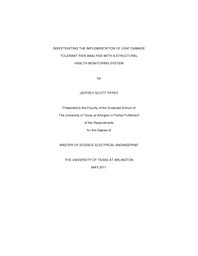
ATTENTION: The works hosted here are being migrated to a new repository that will consolidate resources, improve discoverability, and better show UTA's research impact on the global community. We will update authors as the migration progresses. Please see MavMatrix for more information.
Show simple item record
| dc.contributor.author | Tippey, Jeffrey Scott | en_US |
| dc.date.accessioned | 2011-07-14T20:48:05Z | |
| dc.date.available | 2011-07-14T20:48:05Z | |
| dc.date.issued | 2011-07-14 | |
| dc.date.submitted | January 2011 | en_US |
| dc.identifier.other | DISS-11132 | en_US |
| dc.identifier.uri | http://hdl.handle.net/10106/5656 | |
| dc.description.abstract | The recent improvements in micro fabrication, power management, and distributed sensor networks have made Structural Health Monitoring (SHM) an appealing solution for decreasing costs, decreasing risk of catastrophic failure, and improving overall aircraft health and maintenance (Mukkamala, 2000). A SHM system uses non-destructive inspection (NDI) to provide on-demand updates on the health of a structure, such that the integrity of the structure can be quantified and accounted for (Achenback, 2009). In order to provide an accurate representation of a structure's health, a distributed network of sensors must work in unison to detect a distribution of cracks and damage present on the structure. Each individual sensor or groups of sensors maps a small portion of the structure and the information is then pooled together and processed to provide a representation of the structure's health at any specific instant in time. This representation of the structure's health can then be used to perform a risk analysis which takes into account parameters such as; material properties, mission-loading assumptions, current damage, and time between inspections. These parameters are used to calculate an associated Probability of Fracture (POF) of an aircraft during flight, which can then be used to quantify the health of a fleet of aircraft. Currently, the Air Force uses periodic visual inspections, magnetic-optical imaging (MOI) inspections, and risk analysis to quantify the readiness of its fleet. The goal of this thesis was to investigate the combination of the USAF Structural Risk Methodology with a SHM system and perform a risk analysis for a cargo aircraft. During the study, two different SHM sensor systems were combined with the USAF Structural Risk Methodology and the resulting risk of a cargo lift aircraft was calculated for both systems (P. Hovey A. B., 1998). It is our belief that a SHM system combined with the USAF Structural Risk Methodology can provide substantial savings in the management of the aircraft fleet by eliminating the need for frequent, time consuming, and expensive inspections. | en_US |
| dc.description.sponsorship | Kondraske, George | en_US |
| dc.language.iso | en | en_US |
| dc.publisher | Electrical Engineering | en_US |
| dc.title | Investigating The Implementation Of USAF Damage Tolerant Risk Analysis With A Structural Health Monitoring System | en_US |
| dc.type | M.S. | en_US |
| dc.contributor.committeeChair | Kondraske, George | en_US |
| dc.degree.department | Electrical Engineering | en_US |
| dc.degree.discipline | Electrical Engineering | en_US |
| dc.degree.grantor | University of Texas at Arlington | en_US |
| dc.degree.level | masters | en_US |
| dc.degree.name | M.S. | en_US |
Files in this item
- Name:
- Tippey_uta_2502M_11132.pdf
- Size:
- 1.295Mb
- Format:
- PDF
- Name:
- ThesisDefenseRD.pptx
- Size:
- 1.641Mb
- Format:
- Unknown
This item appears in the following Collection(s)
Show simple item record


